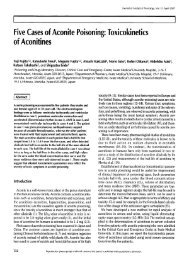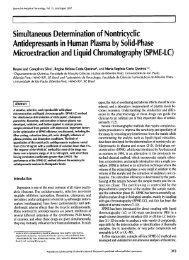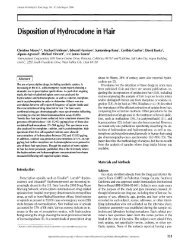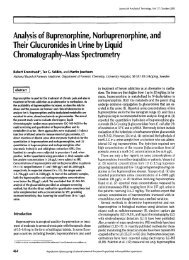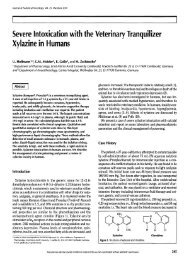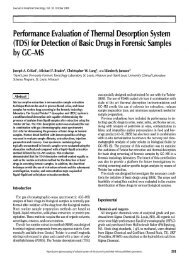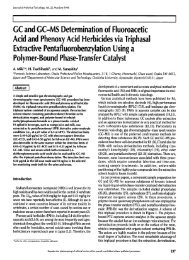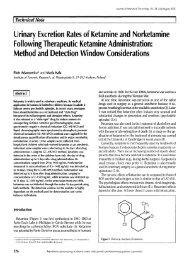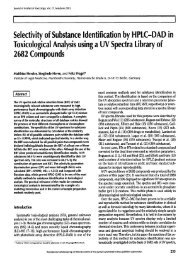Occupational Exposure to Methamphetamine in Workers Preparing ...
Occupational Exposure to Methamphetamine in Workers Preparing ...
Occupational Exposure to Methamphetamine in Workers Preparing ...
Create successful ePaper yourself
Turn your PDF publications into a flip-book with our unique Google optimized e-Paper software.
Journal of Analytical Toxicology, Vol. 30, Oc<strong>to</strong>ber 2006<br />
There is little evidence <strong>in</strong> the literature for potential passive<br />
exposure <strong>to</strong> methamphetam<strong>in</strong>e (MTH) <strong>to</strong> result <strong>in</strong> a positive<br />
ur<strong>in</strong>alysis. Significant problems or issues with illegal MTH production<br />
and child welfare have been addressed (6,7), and use of<br />
ur<strong>in</strong>e and hair test<strong>in</strong>g <strong>to</strong> <strong>in</strong>dicate the exposure of children <strong>to</strong> illicit<br />
drug is often the foundation for removal of the children<br />
from those environments. Most published work related <strong>to</strong> MTH<br />
and occupational exposure details hazards of manufactur<strong>in</strong>g byproducts<br />
and hazardous materials handl<strong>in</strong>g (8).<br />
The purpose of this study was <strong>to</strong> exam<strong>in</strong>e and report the ur<strong>in</strong>alysis<br />
results of NCISRFL staff who manufacture MTH-conta<strong>in</strong><strong>in</strong>g<br />
tra<strong>in</strong><strong>in</strong>g aids and <strong>to</strong> provide some <strong>in</strong>dication of the<br />
potential for passive exposure <strong>to</strong> MTH <strong>in</strong> produc<strong>in</strong>g positive<br />
ur<strong>in</strong>e analysis results.<br />
Methods<br />
Manufacture of tra<strong>in</strong><strong>in</strong>g aids<br />
The manufacture of tra<strong>in</strong><strong>in</strong>g aids consisted of four process<br />
steps: gr<strong>in</strong>d<strong>in</strong>g, weigh<strong>in</strong>g, stuff<strong>in</strong>g, and seal<strong>in</strong>g. Commercially<br />
purchased D-MTH hydrochloride (Chattem Chemical, Chattanooga,<br />
TN) samples <strong>in</strong> excess of the amount required for<br />
preparation were ground <strong>in</strong><strong>to</strong> a f<strong>in</strong>e powder us<strong>in</strong>g a mortar and<br />
pestle. The MTH was then weighed <strong>in</strong><strong>to</strong> quantities of 1-5 g<br />
us<strong>in</strong>g an analytical balance. These weighed samples were transferred<br />
<strong>to</strong> or "stuffed" <strong>in</strong><strong>to</strong> pre-folded filter paper b<strong>in</strong>dles and<br />
stapled closed. The b<strong>in</strong>dles were placed <strong>in</strong><strong>to</strong> 3-oz t<strong>in</strong> canisters<br />
(Figure 1) and sealed with wire and a forensic lead disk.<br />
Ur<strong>in</strong>e samples<br />
Dur<strong>in</strong>g tra<strong>in</strong><strong>in</strong>g aid preparation, NCISRFL staff ur<strong>in</strong>e samples<br />
were collected throughout the day. Generally, ur<strong>in</strong>e samples<br />
were collected from each technician at the beg<strong>in</strong>n<strong>in</strong>g of the<br />
shift, at mid-shift and at the end of each shift. Samples were<br />
s<strong>to</strong>red <strong>in</strong> secured refrigera<strong>to</strong>rs prior <strong>to</strong> shipment <strong>to</strong> NDSL-<br />
Jacksonville for analysis. Samples were ma<strong>in</strong>ta<strong>in</strong>ed under strict<br />
cha<strong>in</strong> of cus<strong>to</strong>dy procedures from collection <strong>to</strong> analysis.<br />
Sample preparation<br />
Ur<strong>in</strong>e samples were analyzed by a solid-phase extraction<br />
method previously described <strong>in</strong> S<strong>to</strong>ut et al. (9). Briefly, samples<br />
were extracted us<strong>in</strong>g SPEWare (San Pedro, CA) columns on a<br />
Speedisk | 48 positive-pressure extraction manifold system.<br />
Deuterated <strong>in</strong>ternal standards of AMP and MTH purchased<br />
from Cerilliant (Round Rock, TX) were added <strong>to</strong> the samples<br />
prior <strong>to</strong> extraction and derivatization. Samples were then analyzed<br />
by a gas chroma<strong>to</strong>graph-mass spectrometer operated <strong>in</strong><br />
electron-impact selected ion moni<strong>to</strong>r<strong>in</strong>g mode. The limit of<br />
quantitation (LOQ) for these MTH analyses was approximately<br />
15 ng/mL, and the limit of detection (LOD, def<strong>in</strong>ed as the<br />
lowest concentration at which all ion ratios, chroma<strong>to</strong>graphy,<br />
and retention times were acceptable) was approximately 1<br />
ng/mL MTH.<br />
Results and Discussion<br />
Table I summarizes the number of <strong>in</strong>dividuals tested, the<br />
<strong>to</strong>tal number of samples analyzed and the distribution of the<br />
times <strong>in</strong> the process that ur<strong>in</strong>e samples were collected. Of the<br />
101 samples analyzed, slightly less than half were collected<br />
prior <strong>to</strong> drug handl<strong>in</strong>g with 6 samples collected dur<strong>in</strong>g process<strong>in</strong>g<br />
(represent<strong>in</strong>g 5 <strong>in</strong>dividuals). Table II presents the MTH<br />
concentration of all 37 samples demonstrat<strong>in</strong>g the presence of<br />
MTH. Ten samples had concentrations greater than the LOQ.<br />
All samples presented <strong>in</strong> Table II were collected dur<strong>in</strong>g or after<br />
production of tra<strong>in</strong><strong>in</strong>g aids with the exception of samples 1 and<br />
4. These samples were collected from the <strong>in</strong>dividual who was<br />
also responsible for the test<strong>in</strong>g of the tra<strong>in</strong><strong>in</strong>g aids and as such<br />
had additional exposure potential outside of produc<strong>in</strong>g the<br />
tra<strong>in</strong><strong>in</strong>g aids. None of the samples conta<strong>in</strong>ed any detectable<br />
levels of AMP.<br />
A solvent blank was <strong>in</strong>jected between each NCISRFL sample,<br />
and <strong>in</strong> all cases, the solvent blank did not demonstrate any<br />
qualitative <strong>in</strong>dication of MTH carry-over. Additionally, process<br />
Table I. Summary of the Samples Collected <strong>in</strong> the Study<br />
Period<br />
Number<br />
Figure 1. Tra<strong>in</strong><strong>in</strong>g aid canister show<strong>in</strong>g filter paper b<strong>in</strong>dle and f<strong>in</strong>al canister<br />
with lead seal.<br />
Individuals tested 5<br />
Total samples analyzed<br />
10r<br />
Samples collected before exposure 49<br />
Samples collected dur<strong>in</strong>g process 6<br />
Samples collected after exposure (next day) 46<br />
552



